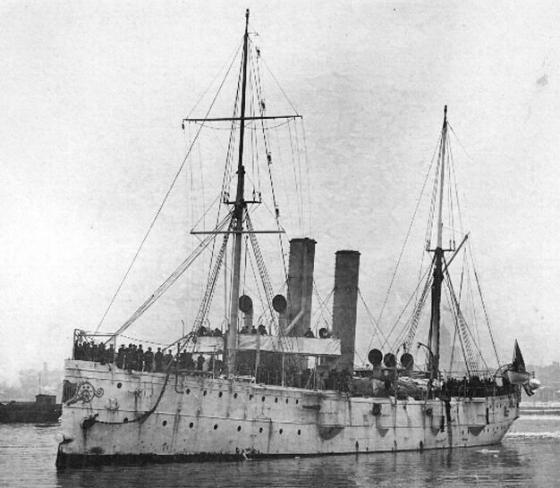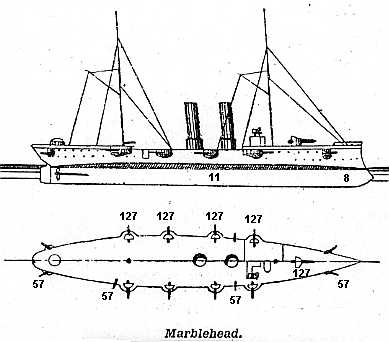


This cruiser was soon integrated in the North Atlantic Squadron. In June 1894, she carried out military operations in Nicaragua since the political instability in that country had provoked a risky situation for lives and interests of US citizens residing in there country. At the beginning of September, she left Nicaraguan waters and cruised the Caribbean, showing the flag, until the 6th of December, the date of her arrival in Hampton Roads, Virginia. During 1895 and 1897 MARBLEHEAD performed goodwill missions in Europe, visiting several seaports of the Atlantic and Mediterranean coasts, and cruised the east coast and the Caribbean in training.
MARBLEHEAD served on the North Atlantic Squadron and, when Rear Admiral Sampson was ordered to blockade the Cuban coast from Cardenas to Bahia Honda, she was sent to the NE of the island and was put in charge of carrying out attacking the Spanish boats.
Once the Cuban North coast was controlled by the US Navy, (25 April 1898), Admiral Sampson decided to expand the blockade to the island’s South coast. Consequently, the cruiser MARBLEHEAD, the gunboat NASHVILLE and the armed yacht EAGLE sailed for Cienfuegos, (480 miles from Havana). MARBLEHEAD and EAGLE (April 26, early morning) went aground at the Arrecifes Colorados, between Bahia Honda and Cabo San Antonio (NW end of the island) and it took 12 hours to free themselves. After this, these ships continued their route to Cienfuegos but they were not in time to intercept the Spanish transport MONTSERRAT, (this vessel was carrying 800 Spanish soldiers).
However, on 29 April 1898, MARBLEHEAD, NASHVILLE and EAGLE intercepted the Spanish supply ship ARGONAUTA, on route from Batabano to Cienfuegos and Santiago. This boat was transporting supplies, rifles and ammunitions, as well as some Army officers, non-commissioned officers and soldiers who were taken prisoners. The Spanish gunboats DIEGO VELAZQUEZ, SATELITE, LINCE and GAVIOTA tried to avoid this capture and attacked EAGLE but MARBLEHEAD and NASHVILLE repelled them. The three American ships shelled also enemy fortifications on the same day. MARBLEHEAD cut the cables off Cienfuegos on the 11th of May. As the result of this dangerous action, in which crewmen in open boats worked within a few hundred feet of the Spanish rifle pit, the greatest number of Medals of Honor were issued for one action in the Spanish American War. After this action, MARBLEHEAD patrolled off Santiago de Cuba until the beginning of June.
Because the blockade of Santiago was supposed to last a long period of time, the US Navy needed an anchoring place where its warships could be supplied with coal, ammunition, etc. and also carry out emergency repairs. The best place for this anchorage was Guantanamo Bay. This bay had been protected with mines by the Spanish gunboat SANDOVAL and another small gunboat. On 7 June 1898, accompanied by the schooner-rigged cruiser YANKEE, and the ST. LOUIS, MARBLEHEAD arrived and fought SANDOVAL at the distance of 3,000 meters. The Spanish gunboat could not prevent the American vessels from sweeping the mines or cutting the submarine telegraph cables. That day MARBLEHEAD captured the lower bay of Guantanamo as a base for the fleet.
On the 10th of June MARBLEHEAD supported the landing of a battalion of Marines there intended for occupying the rest of Guantanamo Bay. The American troops were attacked by SANDOVAL and a small group of Spanish soldiers. Six days later, the USS MARBLEHEAD and USS TEXAS, that had joined her, bombarded the fort on Cayo del Toro in Guantanamo Bay, and reduced the fort to impotency 15 minutes later.
At the end, on 25 June, SANDOVAL’s Commander, being cornered, scuttled his ship. His heroic actions were useless since all the submarine mines not found by ST. LOUIS failed, even when their cables were caught by the propellers of MARBLEHEAD and TEXAS.
MARBLEHEAD remained in Cuban waters until the beginning of September and, after several non-relevant cruises to Canada, the Caribbean, South America and California, she was decommissioned on 30 April 1900. She was recommissioned again on 10 November 1902 for training and protocol missions, and in 1916 was turned over to the Oregon Naval Militia as training ship for that State.
MARBLEHEAD was again placed in full commission 6 April 1917 and was
employed on convoy, patrol, and survey duty during the remainder of
World War I. She was decommissioned 21 August. Reclassified and
sold on 5 August 1921.

| Classification: | Montgomery Class Protected Cuiser C-11 | |
|---|---|---|
| Keel Laid: | October, 1890 | |
| Launched: | August 11, 1892 | |
| Commissioned: | April 2, 1894 | |
| Rig: | Two masted Schooner rig. | |
| Armament: | Ten 127 mm (5 inches) rapid fire guns | |
| Six 57 mm (6 pounder) rapid fire guns | ||
| Two one-pounder rapid fire guns | ||
| Two Colt revolving cannons | ||
| One 3 inch field gun | ||
| Two 18" above-surface torpedo tubes | ||
| Contractor: | City Point Works, Boston, MA | |
| Length: | 257 feet | |
| Beam: | 37 feet | |
| Mean draft: | 14 feet, 7 inches | |
| Max. Draft, fully loaded | 16 feet, 8 inches | |
| Displacement: | 2,089 tons | |
| Complement: | 20 Officers and 228 Enlisted Men, under the command of Commander B. H. McCalla | |
| Engine type: | Two Vertical triple expansion engines, each generating 5,451 hp. at 19 knots | |
| Boiler type: | 3 double-ended and 2 single -ended "scotch" boilers | |
| Coal Bunker Capacity | 340 tons | |
| Normal Coal Supply | 200 tons | |
| Speed: | 18.44 knots | |
| Endurance at 10 knots | 2,900 nautical miles | |
| Armor: | Protective Deck: 8 mm (5/16 inch) on the flat; 11 mm; (7/16 inch) on the slope. | |
|
Wing turrets and blockhouse: 56 mm thick,
(2.2 inches).
|
||
| “Woodite” (cellulose) packed cofferdam 1.20 m (3 feet, 11 inches) height, at the openings of the armored deck for a total of 878 Cubic feet. | ||
| No inner bottom | ||
| Cost | $674,000 |
Admiral Carlos Vila Miranda. España y la Armada en las Guerras de Cuba. Fundación Alvargonzalez. Gijon. 1998.
Agstin R. Rodriguez Gonzalez. La Guerra del 98. Agualarga Editores. Madrid. 1998.
Clerk of Joint Committee on Printing, The Abridgement of Message from the President of the United States to the Two Houses of Congress. (Washington: Government Printing Office, 1899) Vol II, 1094, 1186-1187; Vol. IV 318-319, 373-374
Commandant de Balincourt. Les Flottes de Combat en 1908. Libraire Militaire Berger-Levrault & Cie. Paris. 1908.
DEPARTMENT OF THE NAVY -- NAVAL HISTORICAL CENTER. Online Library of Selected Images. Ships of the Spanish-American War--Cruisers--USS Montgomery, USS Detroit and USS Marblehead. http://www.history.navy.mil/photos/events/spanam/ships/c9-c11/c9-c11.htm
“Dictionary of American Naval Fighting Ships,” (1963) Vol. 2, p.269. http://www.uss-salem.org/danfs/cruisers/c11.txt
NavSource Online: Cruiser Photo Archive. C-11 USS MARBLEHEAD. http://www.cityscope.net/~pry/Archives/CA/c11.htm
THE UNITED STATES NAVY. USS Texas http://www.chinfo.navy.mil/navpalib/ships/battleships/texas/texas.html.